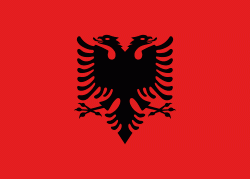Kukës County (Qarku i Kukësit)
The human presence in the lands of modern Kukës County can be traced back to the Bronze Ages, when ancient Illyrians, Dardanians and Romans established settlements in the region. Several Illyrian tombs were discovered in the villages of Këneta and Kolsh close to Kukës.
Kukës is predominantly mountainous and framed by mountain ranges including the Albanian Alps in the northwest which is typified by karst topography. The northeast is dominated by the mountains of Gjallica, Koritnik and Pashtrik, while the southeastern bound is mostly formed by the Korab and Sharr Mountains. At 2694 m, Maja Jezercë is the county's highest peak, and the second highest peak of Albania. Karst topography predominates in the county, resulting in specific landforms and hydrology because of the interaction of the karst and the region's watercourses. It is crossed and drained by the Drin river. The county is also home to the sources of rivers such as the Valbona which is part of Tropojë,originates south of Maja Jezercë and Gashi a notable tributary of Valbona.
Located in the north of Albania, the climate is alpine and continental. Mean monthly temperature ranges between 11 °C (in January) and 25 °C (in July). Mean annual precipitation ranges between 900 mm and 3000 mm depending on geographic region and prevailing climate type.
According to the last national census from 2011 this county has 85,292 inhabitants. They are mostly Muslim and a significant Catholic Christian minority are present. They speak the Gheg dialect.
Kukës is one of 12 counties of Albania, located in the north and northeast of the Northern Region. The county area is 2374 km2 and the seventh largest county by area in Albania and the third largest in the Northern Region, behind Shkodër County and Dibër County. It is bordered by the counties of Shkodër County in the west, Dibër County in the south, Lezhë County in the southeast, the countries of Kosovo in the east and northeast and Montenegro in the north and northwest. Its northernmost point is Çerem point at 42° 29' 52" northern latitude; the southernmost is Kalis point at 41° 50' 0" northern latitude; the westernmost point is Rrogam at 19° 50' 24" eastern longitude; and the easternmost point is Shishtavec at 20° 36' 0" eastern longitude.
The terrain of the county consists of small plains and high mountains. Elevations here range between 250 m and 2200 m. The Albanian Alps are a high mountain range running through Tropojë across the northwest of the county. The northeast contain high and steep peaks including Gjallica, Koritnik and Pashtrik. Between these mountains are mostly narrow valleys, canyons and ravines. From southeast, the county is crossed by the Sharr and Korab Mountains. Hydrologically, the county lies almost entirely within the basin of the Drin and its tributaries. The river flows into the Adriatic Sea after crossing the county territory from the confluence of Black Drin and White Drin. On their way, its basin and zone of influence naturally correspond to the areas destined for agricultural use. Lake Fierza and Koman lies in the county and are fed and drained by rivers Black Drin and White Drin. Other notable rivers include Gashi and Valbona.
Phytogeographically, the county falls within the Dinaric Mountains mixed forests and Balkan mixed forests terrestrial ecoregions of the Palearctic temperate broadleaf and mixed forest. The Balkan mixed forests occupy the eastern portion of the county. Inside the county, there are a national parks, a nature park and a nature reserve, which include the Valbonë Valley National Park, Korab-Koritnik Nature Park and the Gashi River Nature Reserve. The northern and eastern bound of the county forms a part of the European Green Belt, which serves as a retreat for endangered mammal and plant species. Furthermore, the Gashi River was declared a UNESCO World Heritage Site as part of the Primeval beech forests of the Carpathians and other regions of Europe.
Map - Kukës County (Qarku i Kukësit)
Map
Country - Albania
 |
 |
| Flag of Albania | |
Albania has been inhabited by different civilisations over time, such as the Illyrians, Thracians, Ancient Greeks, Romans, Byzantines, Venetians, and Ottomans. The Albanians established the autonomous Principality of Arbër in the 12th century. The Kingdom of Albania and Principality of Albania formed between the 13th and 14th centuries. Prior to the Ottoman conquest of Albania in the 15th century, the Albanian resistance to Ottoman expansion into Europe led by Skanderbeg won them acclaim over most of Europe. Albania remained under Ottoman rule for nearly five centuries, during which many Albanians (known as Arnauts) attained high-ranking offices in the empire, especially in the Southern Balkans and Egypt. Between the 18th and 19th centuries, cultural developments, widely attributed to Albanians having gathered both spiritual and intellectual strength, conclusively led to the Albanian Renaissance. After the defeat of the Ottomans in the Balkan Wars, the modern nation state of Albania declared independence in 1912. In the 20th century, the Kingdom of Albania was invaded by Italy, which formed Greater Albania before becoming a protectorate of Nazi Germany. Enver Hoxha formed the People's Socialist Republic of Albania after World War II, modeled under the terms of Hoxhaism. The Revolutions of 1991 concluded the fall of communism in Albania and eventually the establishment of the current Republic of Albania.
Currency / Language
| ISO | Currency | Symbol | Significant figures |
|---|---|---|---|
| ALL | Albanian lek | L | 2 |
| ISO | Language |
|---|---|
| SQ | Albanian language |
| EL | Greek language |
















